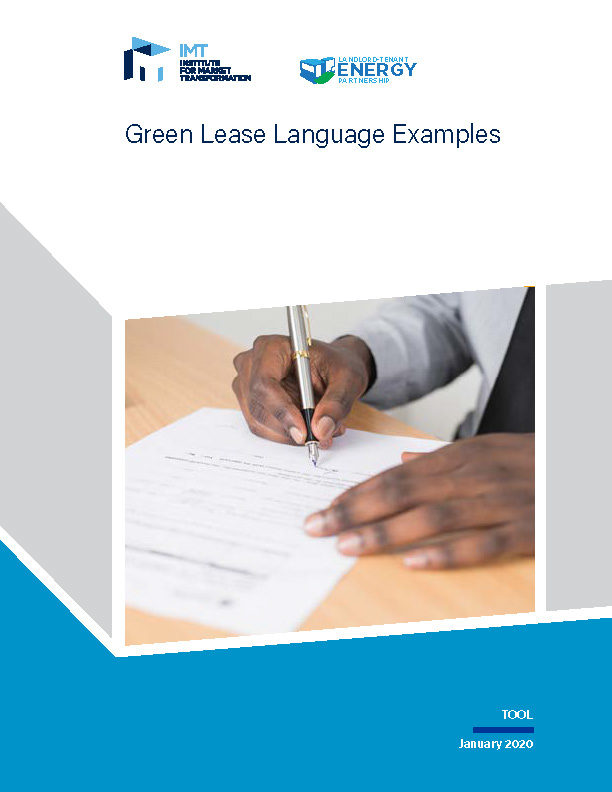As IMT Associate Director Audi Banny has made clear—and many in real estate are now painfully aware of—leases are critical to reducing building energy use. Traditional leases are not flexible in times of crisis, and often have clauses requiring buildings to meet criteria for heat or cooling that only make sense if a building is occupied. Green leases are proving to be a promising solution to these hurdles and the Green Lease Leaders program offers guidance on a proven way forward.
The program, launched in 2014 by the U.S. Department of Energy’s Better Buildings Alliance and IMT, has recognized landlords, tenants, and their partners for industry-leading leasing efforts across nearly three billion square feet of building space. Recently the program expanded its requirements to enable recognition for multifamily building owners. To talk about why that expansion is important, and the future of green leasing, IMT interviewed Hannah Debelius, Fellow at the U.S. Department of Energy.
Hannah, what is your role in the U.S. Department of Energy and how did you become involved with the Green Lease Leaders program??
I am a Science, Technology, and Policy Fellow in the Building Technologies Office at the U.S. Department of Energy. Through the Better Buildings initiative, I work with industry leaders to set and achieve ambitious energy efficiency goals. To catalyze these achievements, we leverage success stories and tackle technical and non-technical barriers such as the split incentive. In partnership with IMT, the Green Lease Leaders program has addressed market barriers and elevated the many benefits of green leasing practices across building sectors.
Why is it important to expand green leases to multifamily buildings?
In the United States, nearly 40 million people live in multifamily rental housing. Higher bills and energy cost burdens for residents are more prominent in multifamily properties than single family, owner-occupied homes due, in part, to the age of the building stock. These inefficiencies represent a huge potential for green leasing practices to not only reduce energy use but reduce cost to residents. A 2017 report by the American Council for an Energy-Efficient Economy (ACEEE) estimates that multifamily energy efficiency has the potential to result in $3.4 billion in savings per year. (Source: NASEO)
Energy efficiency is just one potential benefit green leasing can bring to multifamily buildings. Water efficiency, improved health and comfort, and more general engagement in sustainable living can all result from robust green leasing efforts. IMT and DOE engaged both existing Green Lease Leaders and multifamily buildings stakeholders in the process of expanding to this sector and updating resources in order to ensure it was the right time for expansion and that the Green Lease Leaders program was ready to support multifamily owners in achieving recognition.
What are the unique challenges that multifamily buildings face in greening their leases, and how does the Green Lease Leader program address those?
Unlike commercial leases, residential lease agreements cannot include cost recovery clauses allowing amortization and recovery costs from residents, due to short lease terms. Therefore, the split incentive barrier is difficult to overcome in this market. As an alternative solution recommended through our stakeholder engagement efforts, Green Lease Leaders has added a new prerequisite specific to multifamily that focuses on implementing efficiency upgrades when units are vacant between residents.
An additional barrier for multifamily building owners is access to tenant utility data. Green Lease Leaders has included example lease language that can be used to support transparency, help with compliance for benchmarking mandates, and assist data collection for ESG reporting, such as GRESB, while still maintaining tenant privacy.
What types of multifamily real estate companies should apply?
Green Lease Leaders provides guidance that is widely applicable across the real estate market, supporting no-to-low cost recommendations to improve energy efficiency and opening the door to recognition for a variety of multifamily owners. Real estate firms that own a mixture of building types including multifamily or exclusively multifamily that are from Class A to Class C are encouraged to pursue green leasing and apply for Green lease Leaders recognition. A great first step is to use the Lease Audit Tool to assess your current practices and quickly see if you meet key requirements..
What role could green leases play in an economic recovery from the pandemic?
As people are spending more time at home due the pandemic, it is increasingly important to preserve housing affordability and support resident health and wellness. Green leasing is a key tool in Improving energy efficiency in tenant spaces and addressing sustainability practices, which contribute to those objectives. While reduced utility bills can help tenants with affordability, these measures can additionally benefit the landlord through reduced turnover of tenants so that both sides of the lease agreement can contribute to an economic recovery.
Additionally, establishing a contact for sustainability on behalf of the owner or sharing key information about energy efficiency and sustainability efforts, a prerequisite for Green Lease Leaders recognition, ensures transparency and sets up a relationship where tenants and owners are partners in energy efficiency. This relationship can be called upon or adapted to future challenges in utilities and resilience, aiding in a smoother recovery.
The Green Lease Leaders program for 2021 will accept applications through March 31, 2021 and winners will be announced in spring/summer 2021.
